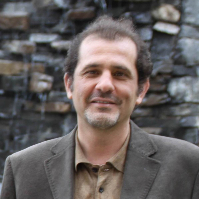Ecological Landscape Planning Approach, Case Study: Strategies for Development of Green Open Spaces in 19th Region of Tehran
Author(s):
Abstract:
Unbalanced development of spatial- physical dimensions of cities, continuously diminishes green open spaces in suburban areas. Landscape is where the slow, natural processes of growth and maturity and decay are deliberately set aside and history is substituted. Recent interruptions without any historic implications cause the environmental problems. Landscape as a dynamic system permanently has been modified by human intentional changes. Most of times unwise interferes leads to demolition and produce landscape ruin. Specifically green open spaces in suburban areas have been irreparably altered by both excessive population growth and unplanned city developments. Those adverse growths have short term contradictory consequences for being healthy and demonstrate worse conditions for biodiversity and lead to offensive scenery. Acknowledging the holistic attitude about relationship between man and the nature, landscape ecology approach has indispensable effects on sustainable landscape planning. Indeed, ecological landscape planning is able to establish the conceptual framework and conduct green open space areas through comprehensive strategies. This study aims to explain main phases of ecological landscape planning process by descriptive content analysis in landscape architecture literature, with purpose of identifying strategies for development of green open areas through cities and suburbia. According to the literature review, two general stage of common planning process are survey and analysis and prescribe solutions which constitute procedural stages of planning. The analysis of ecological landscape planning is mainly based on the application of both quantitative attributes and spatial concepts. Hereby, our assumption is based on the patch-corridor-matrix model and framework concept, as spatial concept is thoroughly investigated. Patch-corridor-matrix model -was coined by Forman (1986-1995) and other pioneers of Landscape Ecology discipline- emphasizes on spatial structure with discussion about composition and configuration of landscape patterns. This model has guiding principles for ecological landscape planning and design. Besides framework concept with significant attention to watersheds, has specific clues for allocation resources to land use applications. Specifically framework concept is in parallel with Human Ecosystem notion which had been developed by Lyle (1985). Taking the generalized axioms of these concepts into account, in comparison with precedent studies about Tehrans landscape spatial structure at regional scale which was performed by quantitative methods, (Aminzadeh & khansefid, 200; Parivar et al., 2009; Baftshahr, 2009; Shabani et al., 2010), lead to classification. The content of these prior studies was reviewed and their finding by comparison with Formans model, was generalized. In addition, for more insight, filed observations of 19th region of Tehran was performed, because of abundance fragmented suburbia in large landscape scale that are scattered in 19th region. Regional comprehensive studies of Tehran defines the marginal lands of 19th region as greenbelts which are cross junctions of North-south corridors with suburban agricultural lands. In regular observations during 2012 and 2013, it was seen that strategies of landscape urbanism, would be applied in those suburbia. These qualitative investigations were aided in classifying green open spaces in suburban areas of Tehran. Generalized axioms derived from this study are proposed in table-3 and table-4. Consequently various suburban areas of Tehran with natural potentials can be divided into three main groups, namely productive, conservative, and compromise areas. Furthermore, basic strategies are proposed and generalized with regard to one case study in 19th region of Tehran which has capabilities of suburbia and natural areas. Eventually, it has been proven that many of green open spaces of 19th region of Tehran have characteristics in parallel with those of compromise areas. Following up the content analysis and Authors personal observations, Ecological Landscape Planning Approach in suburban areas must be implement by proposing environmental friendly mixed uses during short times. Landscape consistency highly depends on great deal of efforts for recognizing Compromise areas. Development of green open spaces throughout compromise areas must be implemented according to integration and connection concepts in ecological landscape planning, which connote the healthy condition of natural environments. So Ecological Landscape Planning Approach in compromise areas must be scheduled and implemented which enhances tolled concepts in large and small scales (Table-4). Concentration on field observation with emphasis on Nemat Abad district in 19th region of Tehran, as a remarkable brownfield, implies heterogeneous mixture of agricultural, industrial and residential patches inside of suburbia (photo1 & 2). Obviously most of these heterogeneities with the characteristics of Compromise areas, are caused by lack of integrated strategies. Landscape planning approach with emphasis on integration and connection concepts should be elaborated in those areas. According to landscape architecture attitude, Outcome of this study establishes preliminary approach toward policy making about suburbias green open spaces.
Keywords:
Language:
Persian
Published:
Journal of Architect, Urban Design & Urban Planning, Volume:10 Issue: 19, 2017
Pages:
11 to 21
magiran.com/p1749075
دانلود و مطالعه متن این مقاله با یکی از روشهای زیر امکان پذیر است:
اشتراک شخصی
با عضویت و پرداخت آنلاین حق اشتراک یکساله به مبلغ 1,390,000ريال میتوانید 70 عنوان مطلب دانلود کنید!
اشتراک سازمانی
به کتابخانه دانشگاه یا محل کار خود پیشنهاد کنید تا اشتراک سازمانی این پایگاه را برای دسترسی نامحدود همه کاربران به متن مطالب تهیه نمایند!
توجه!
- حق عضویت دریافتی صرف حمایت از نشریات عضو و نگهداری، تکمیل و توسعه مگیران میشود.
- پرداخت حق اشتراک و دانلود مقالات اجازه بازنشر آن در سایر رسانههای چاپی و دیجیتال را به کاربر نمیدهد.
In order to view content subscription is required
Personal subscription
Subscribe magiran.com for 70 € euros via PayPal and download 70 articles during a year.
Organization subscription
Please contact us to subscribe your university or library for unlimited access!



